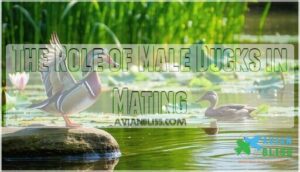This site is supported by our readers. We may earn a commission, at no cost to you, if you purchase through links.

However, some species like Wood Ducks and Goldeneyes break this pattern by maintaining longer-term relationships across multiple seasons. Think of it as nature’s version of "it’s complicated"—environmental factors, habitat quality, and food availability all influence whether your feathered friends stick together or play the field.
Understanding these mating patterns reveals fascinating insights about duck behavior and survival strategies.
Table Of Contents
- Key Takeaways
- Do Ducks Mate for Life?
- Duck Mating Systems Explained
- The Role of Male Ducks in Mating
- Female Duck Mating Habits
- What Happens When a Duck’s Partner Dies?
- Do Mallard Ducks Stay Together?
- Duck Mating Season and Breeding
- Duck Love Isn’t Always Binary
- Duck Conservation and Mating
- Frequently Asked Questions (FAQs)
- How often do ducks mate?
- Do ducks mate for life?
- What happens when ducks mate?
- Do goldeneye ducks mate for life?
- Do maccoa ducks mate for life?
- Do comb ducks mate for life?
- Do ducks mourn the loss of a mate?
- What happens when a ducks partner dies?
- Do male and female Mallard ducks stay together?
- What ducks are monogamous?
- Conclusion
Key Takeaways
- You’ll discover most ducks don’t mate for life – they practice seasonal monogamy, forming pair bonds that last just one 4-8 month breeding season before choosing new partners the following year.
- You can identify truly monogamous species like Wood Ducks and Goldeneyes that break the typical pattern by maintaining multi-year partnerships and returning to the same mates across multiple breeding seasons.
- You’ll notice environmental factors heavily influence their mating choices – habitat quality, food availability, and population density all determine whether ducks stick together or seek new partners each season.
- You should expect different parenting roles between species – while most males abandon females after mating, monogamous species show males actively participating in nest defense, incubation, and duckling care alongside their long-term partners.
Do Ducks Mate for Life?
If you’ve ever watched ducks paddling together at your local pond, you might wonder whether they’re lifelong partners like swans.
Most duck species don’t mate for life, instead forming seasonal pair bonds that last only through one breeding season, usually 4-8 months.
Monogamous Duck Species
While most duck species practice seasonal monogamy, several notable exceptions form lifelong pair bonds. Buffleheads frequently reunite with previous mates across multiple breeding seasons, demonstrating outstanding site fidelity. Common Goldeneyes also show strong tendencies for annual reunions, particularly in stable populations.
These monogamous pairings contrast sharply with typical duck courtship patterns, where Mallard ducks and other species select new partners each year through elaborate mating rituals. Understanding duck mating habits involves studying their water animal behavior.
Seasonal Monogamy in Ducks
Partnership patterns in waterfowl reveal fascinating seasonal monogamy strategies. Most duck species form pair bonds during winter months, practicing seasonal mating through dedicated breeding cycles.
These monogamous pairings last 4-8 months, with males defending territory while females handle mate selection. Unlike lifelong commitments, seasonal monogamists prioritize successful reproduction over permanent relationships, demonstrating nature’s practical approach to monogamous behavior.
Factors Influencing Mating Systems
Multiple factors shape whether ducks form lifelong bonds or practice seasonal monogamy. Habitat quality influences pair bond stability—abundant food sources and protected nesting sites encourage monogamy. Ecological pressures like predation risk drive different mating behaviors, while genetic variation affects evolutionary adaptations.
Social learning from other ducks also influences whether species mate for life or form temporary partnerships. Understanding duck courtship rituals is essential for insights into their relationships.
Duck Mating Systems Explained
You’ll discover that duck mating systems vary dramatically across species, from seasonal partnerships that last just one breeding season to rare lifelong bonds.
Most ducks practice seasonal monogamy, forming pair bonds between December and March that dissolve after nesting, while others engage in polygamous arrangements where males mate with multiple females.
Long-term Pair Bonds
While most ducks practice seasonal monogamy, some waterfowl species break the mold with lifelong pair bonds that span multiple breeding seasons. These long-term partnerships demonstrate outstanding mate fidelity, creating stable relationships that boost reproductive success.
- Wood ducks usually maintain the same partner across years
- Certain geese species show monogamous behavior lasting decades
- These pairs coordinate breeding seasonality and territory defense together
Short-term Pair Bonds
Most waterfowl don’t stick around for the long haul like their lifelong counterparts. Instead, you’ll find that many species practice seasonal monogamy, forming temporary partners for just one breeding cycle. These short-term pair bonds usually last four to eight months, perfectly timed with nature’s reproductive schedule.
Here’s what makes these seasonal mates tick:
- Mate switching occurs annually, with new partners chosen each breeding season
- Pair bonding begins on wintering grounds between December and March
- Breeding cycles determine bond duration, ending after egg-laying or hatching
- Temporary partners separate once reproductive duties are complete
This flexible approach to duck mating allows species to increase genetic diversity while adapting to changing environmental conditions.
Polygamous Mating Systems
Unlike species with short-term bonds, some ducks embrace polygamy where one male mates with multiple females. Polygynous species like Ruddy Ducks establish territories, competing fiercely for access to several partners. This breeding strategy maximizes genetic diversity while creating complex social structures.
| Species | Mating System | Male Strategy |
|---|---|---|
| Ruddy Duck | Polygynous | Territory defense |
| Musk Duck | Polygamous | Display competition |
| Mallard | Mixed system | Opportunistic |
| Wood Duck | Monogamous | Pair bonding |
These mating behaviors showcase nature’s diverse courtship rituals and reproductive approaches.
The Role of Male Ducks in Mating
You’ll observe that male ducks take on dramatically different roles depending on their species, from aggressive competitors who abandon their mates after breeding to devoted partners who help raise ducklings.
Research shows that males in species like wood ducks perform elaborate courtship displays with head-bobbing and wing-flapping, while others like ruddy ducks engage in intense territorial battles that can determine their mating success.
Aggressive Mating Behaviors
Three out of every four male ducks you’ll encounter display surprisingly aggressive mating behaviors that can shock first-time observers. These territorial fights and mate competition create a breeding battlefield where male dominance rules paramount.
Here’s what you’ll witness during peak breeding season:
- Groups of males form "wolf packs" pursuing lone females relentlessly
- Forced copulation attempts occur in up to 20% of all duck encounters
- Aggressive courtship leads to severe feather loss and visible injuries on females
- Breeding aggression intensifies when male-to-female ratios become unbalanced
- Territorial fights between rival males can result in drowning or serious harm
This male-male competition stems from high testosterone levels and evolutionary pressure to pass on genes. You’ll notice these mating behaviors are most intense during egg-laying phases, when fertilization chances peak.
Male Duck Courtship Displays
Male duck courtship displays showcase nature’s most enchanting mating signals. You’ll witness head-bobbing rhythms that mesmerize females, while vibrant male plumage creates stunning visual spectacles. These display behaviors aren’t just show-offs—they’re strategic mating rituals.
Duck courtship involves elaborate preening sessions where males groom themselves thoroughly. Mallard duck mating exemplifies classic courtship displays: males whistle softly, grunt purposefully, and perform ritualized mock battles. Each vocalization acts as a personality showcase, helping females assess potential partners.
Male ducks understand that successful reproduction depends on impressing their audience through these intricate behavioral performances that demonstrate health and genetic fitness. The establishment of territories is often a result of bird territorial displays.
Male Duck Parenting Roles
Duck fathers break the deadbeat dad stereotype more than you’d think. While many male ducks abandon their mates after mating, some species show impressive fatherly instincts that rival any devoted parent.
- Nest guardians: Male ducks fiercely defend territories and nesting sites from predators and rival males
- Teaching mentors: Some males actively participate in brood rearing, showing ducklings prime foraging spots and safety techniques
- Investment partners: Biparental care increases duckling survival rates, making male parental investment a smart evolutionary strategy
Duck family dynamics vary widely across species, with some males providing substantial duckling protection while others focus solely on territory defense.
Female Duck Mating Habits
When you observe female ducks during breeding season, you’ll notice they’re incredibly selective about their mates, carefully evaluating male courtship displays before making their choice.
After mating, female ducks take on the demanding role of incubating eggs for about 28 days and raising ducklings alone, since most males abandon their partners once breeding is complete.
Female Duck Mate Choice
When choosing mates, female ducks aren’t easily impressed. They evaluate males based on territory quality, physical condition, and courtship performance.
Bright plumage signals good health, while elaborate displays demonstrate genetic fitness. Female ducks control mate selection, often rejecting multiple suitors before choosing.
This careful screening ensures their offspring inherit exceptional traits for survival and reproduction success.
Female Duck Reproductive Cycles
Understanding reproductive cycles helps explain female fertility patterns in ducks. Female ducks usually lay eggs each morning during breeding season, producing clutch sizes of 8-13 eggs depending on species. Their hormonal cycles regulate this egg laying process, with fertility peaking during ideal environmental conditions.
The incubation period lasts approximately 28 days, during which females maintain consistent temperatures and humidity. These reproductive health patterns directly influence duck mating success and population dynamics across different habitats.
Female Duck Parenting Roles
After laying eggs, you’ll observe female ducks shouldering complete Duckling Care responsibilities. She takes Egg Incubation solo for roughly 28 days, demonstrating strong Parental Instincts.
Once hatched, female ducks guide ducklings to water within hours, teaching swimming and foraging. Her Female Brooding behavior includes protection from predators and weather. This intensive duck parenting continues until ducklings fledge at eight weeks.
What Happens When a Duck’s Partner Dies?
When you’re watching ducks and suddenly one partner disappears, you’ll notice the surviving duck doesn’t grieve like humans do. Instead, most duck species quickly seek new mates since their seasonal bonds prioritize reproduction over long-term attachment, and delayed breeding reduces their chances of successful offspring that year.
Re-pairing in Ducks
When heartbreak strikes the wetlands, ducks don’t wallow in grief for long. They’re masters of moving forward, quickly seeking new companions through a process called mate switching. Unlike humans who might spend months healing, ducks understand that survival depends on finding fresh pair bonds before the next breeding cycles begin.
Most ducks practice seasonal monogamy, forming partnerships that last just one season. When death breaks these bonds, the surviving duck immediately begins rebreeding strategies. Species like goldeneyes and buffleheads show outstanding resilience, often finding new mates within weeks.
- Duck reunion with familiar birds increases pairing success rates
- Older ducks excel at mate switching due to their social experience
- Divorce rates climb when resources become scarce or territories overlap
This practical approach ensures reproductive success continues despite loss. Ducks also exhibit impressive social intelligence skills that help them navigate complex relationships and find new mates efficiently.
Delayed Breeding After Mate Loss
When a duck loses its mate, breeding doesn’t just pause—it gets complicated. Research shows 97% of mallards re-pair within the same season, but timing matters. Late-season mate loss hits hardest, with widowed females laying up to 1.91 fewer eggs in their first nests.
This breeding delay can slash yearling recruitment by 20%. Wood ducks bounce back faster than mallards, while some species show minimal reproductive pause after pair bond recovery.
Impact of Mate Loss on Duck Behavior
When mate loss hits, ducks don’t grieve like humans, but behavioral changes are real. You’ll observe significant impacts affecting their survival and future breeding success.
The effects manifest through:
- Social isolation from flock activities
- Reduced feeding behaviors and weight loss
- Delayed or skipped reproductive cycles
- Increased vulnerability to predators
These behavioral changes show that pair bonds matter deeply in duck biology, even without lifelong monogamy.
Do Mallard Ducks Stay Together?
You’ll find that mallard ducks don’t stay together for life, instead forming seasonal pair bonds that usually last through one breeding cycle.
These common waterfowl demonstrate the classic pattern of seasonal monogamy, where pairs separate after the female begins incubating eggs and the male abandons parenting duties.
Mallard Duck Mating Season
When spring arrives, you’ll witness Mallard Courtship in full swing during their mating season from March through late May. Mallard ducks transform into vibrant performers as males showcase emerald-green heads and engage in Mating Rituals featuring head-bobbing displays.
This Seasonal Behavior creates intense competition in their Duck Habitat, where testosterone-fueled males compete aggressively for female attention through elaborate Breeding Patterns.
Mallard Duck Pair Bonding
Through seasonal partnerships, you’ll discover Mallard Bonding isn’t lifelong but remarkably strong. These ducks form pair bonds during fall migration, maintaining mate fidelity through winter months.
Duck Socialization patterns show pair formation occurs before breeding season begins. Mallard duck behavior demonstrates monogamy within single seasons rather than true lifelong commitment.
Their breeding strategies involve coordinated courtship displays and shared nest site selection responsibilities.
Mallard Duck Parenting Roles
In the context of Mallard duck parenting, you’ll notice a stark gender divide in responsibilities. Female duck behavior centers on total dedication to Duckling Care and Brood Rearing. She manages Nesting Habits, incubation, and Fledgling Support solo. Male mallard duck involvement ends after mating, leaving Parental Bonds exclusively between mother and offspring. These ducks are highly adaptable, thriving in urban and suburban areas.
Key aspects of Mallard duck behavior in parental care:
- Female builds nest alone and incubates 8-13 eggs for 28 days
- Mother teaches ducklings swimming, foraging, and predator avoidance skills
- Male abandons family responsibilities immediately after fertilization occurs
- Ducklings stay with mother for 7-9 weeks until they’re flight-ready
- Female fiercely defends her brood from threats and rival ducks
Characteristics of Monogamous Ducks
Waterfowl specialists recognize distinct patterns when identifying truly monogamous ducks. These birds display genetic monogamy, maintaining the same partner across multiple breeding seasons rather than practicing seasonal monogamy like most mallard ducks. Pair bonding strengthens through shared mating rituals and duck courtship displays that reinforce their commitment.
Key characteristics of monogamous duck species include:
- Bright, elaborate plumage – Males invest in impressive feathers to attract and keep mates
- Shared nest site fidelity – Both partners return to familiar breeding territories yearly
- Active male parental care – Fathers help incubate eggs and protect ducklings
- Synchronized breeding cycles – Partners coordinate timing for ideal reproductive success
- Low mate switching rates – Divorce rarely occurs, even after unsuccessful breeding attempts
Examples of Monogamous Duck Species
Several duck species demonstrate true monogamous behavior. Wood Ducks often reunite with previous mates across multiple seasons. Goldeneye Ducks show notable partner fidelity, returning to identical breeding territories yearly. Buffleheads maintain multi-year pair bonds, while Mallards usually practice seasonal monogamy.
| Species | Bond Duration | Site Fidelity |
|---|---|---|
| Wood Ducks | Multi-year | High |
| Goldeneye Ducks | Multi-year | Very High |
| Buffleheads | 2-3+ years | High |
| Mallards | Single season | Moderate |
Benefits of Monogamy in Ducks
Nature’s pair bonding offers practical advantages that boost survival rates. When you observe monogamous duck species, you’ll notice they thrive through shared responsibilities. Paired males protect their mates from harassment by other males, giving females access to better foraging areas. These lifelong pair bonding relationships create social stability that translates into breeding success.
Monogamy advantages become clear when you consider:
- Enhanced territory defense: Two birds guard nests and resources more effectively than one.
- Improved chick survival: Both parents contribute to protection and feeding responsibilities.
- Reduced energy waste: Mate fidelity eliminates constant courtship displays and competition.
This pair bonding ensures cooperative parenting and protection of their young. Do ducks mate for life? While most practice seasonal monogamy, those species maintaining year-round bonds demonstrate exceptional reproductive outcomes through coordinated efforts.
Duck Mating Season and Breeding
You’ll find that duck mating season usually occurs between December and March, when pairs form strong seasonal bonds at their wintering grounds.
Most duck species breed once per year during spring and early summer, with females selecting mates based on elaborate courtship displays, vibrant plumage, and territorial behaviors that indicate genetic fitness.
Timing of Duck Mating Season
Duck courtship begins when winter frost melts away. Mallards start courting in fall and early winter, while breeding season occurs in spring and early summer for most wild ducks.
Peak nesting starts in late April through May. These seasonal breeding cycles align perfectly with nature’s abundance, ensuring ducklings have ideal survival chances.
Duck Breeding Habits
Most duck breeding patterns follow predictable cycles that might surprise you. These seasonal monogamy experts don’t just wing it when it comes to reproduction. Duck breeding habits reveal fascinating behaviors across different species and environments.
Here are three key aspects of duck breeding patterns:
- Nesting habits: Females construct elaborate nests using vegetation, down feathers, and natural materials in protected locations
- Egg incubation: Most species require 25-35 days of constant warming, with females rarely leaving their clutches
- Flock dynamics: Males usually abandon partners after mating, leaving females to handle parental duties independently
Understanding these mating habits of ducks helps explain why duck migration timing coincides with breeding cycles, ensuring favorable conditions for successful reproduction. The study of bird mating systems is vital in understanding the nuances of duck relationships and behaviors.
Factors Influencing Duck Fertility
Looking for what makes ducks successful breeders? You’ll find five key factors that determine reproductive success during breeding season.
Duck Nutrition tops the list—adequate zinc levels boost fertility rates substantially. Breeding Age matters too, with mature pairs achieving 80% fertility versus just 7% for yearlings. Environmental Stress from high temperatures can slash hatch rates from 78% to 46%. Habitat Quality, including clean water access, improves mating rates naturally.
| Factor | Impact on Fertility |
|---|---|
| Proper nutrition (zinc) | Increases egg production |
| Mature breeding pairs | 80% vs 7% success rate |
| Cool temperatures | Higher hatch rates |
| Clean water access | Better mating success |
| Genetic Diversity | Stronger reproductive output |
Effective duck breeding requires access to quality breeding supply products. These reproductive strategies help explain duck mating habits and successful incubation periods across species.
Duck Love Isn’t Always Binary
When you observe ducks in the wild, you’ll notice their mating behaviors aren’t limited to traditional male-female pairs. Researchers have documented same-sex courtship displays and complex sexual interactions across multiple species.
These behaviors, including male-male pair bonding in mallards and female-female partnerships in various waterfowl, demonstrate that duck sexuality exists on a spectrum rather than following strict binary patterns.
Homosexual Behavior in Ducks
Beyond traditional pair bonding, you’ll find notable same-sex pairing in duck populations. Research shows up to 20% of male mallards form homosexual courtship bonds, displaying typical mating behaviors like head-bobbing and territory sharing.
These gay duck behavior patterns aren’t random – they serve important social functions, reducing aggression and maintaining flock stability. Duck sexual diversity includes everything from brief encounters to season-long partnerships, proving that queer waterfowl relationships are perfectly natural evolutionary adaptations.
Bisexual Behavior in Ducks
Researchers have documented fascinating examples of duck sexual fluidity that challenge traditional mating assumptions. Unlike species that mate for life, many ducks demonstrate bisexual mating patterns throughout their lives. Field observations reveal four key aspects of avian sexual diversity:
- Flexible partnerships: Ducks form same-sex pairing arrangements that mirror heterosexual bonds in duration and intensity.
- Seasonal switching: Individual ducks may pursue different-sex partners one season, then same-sex partners the next.
- Courtship versatility: Males perform identical display behaviors regardless of their target’s gender.
- Social acceptance: Duck flocks readily integrate diverse pairing arrangements without conflict.
This duck gender expression represents nature’s pragmatic approach to reproduction and social bonding, demonstrating that rigid monogamy isn’t always the evolutionary advantage we might expect.
Complexities of Duck Mating Systems
Understanding duck mating systems reveals nature’s impressive flexibility. These birds don’t follow simple rules about monogamy or pair formation. Duck social bonds range from seasonal partnerships to complex arrangements involving genetic diversity across breeding cycles.
Some species demonstrate traditional mating rituals, while others break conventional patterns entirely. Duck mating systems showcase evolutionary adaptation at its finest.
Duck Conservation and Mating
You can’t truly understand duck mating patterns without considering the conservation pressures these birds face today.
Habitat loss, climate change, and human interference create uneven sex ratios in many populations, with some declining species showing up to 80% males, which directly impacts pair formation and breeding success.
Threats to Duck Populations
Duck populations face mounting pressure that threatens their genetic monogamy and nest site fidelity. While their mating nuances fascinate us, survival challenges demand attention. Here’s what’s endangering these birds:
- Habitat Loss: Wetland drainage destroys critical breeding grounds, reducing duck populations by 30% since 2017
- Climate Change: Shifting migration patterns and prolonged droughts decreased mallard populations by 23% recently
- Pollution Effects: Agricultural runoff and chemical contamination cause reproductive failure and waterbird die-offs
Conservation Efforts for Ducks
Wildlife conservation groups have launched thorough initiatives to protect duck populations. Habitat preservation through wetland restoration creates essential breeding grounds for Mallard ducks and other species. Wildlife refuges provide protected zones where pair bonds can form naturally during duck migration periods. Population management programs monitor ecosystem balance while ensuring species protection remains effective. Effective conservation relies on using proper duck conservation products to support these initiatives.
| Conservation Strategy | Primary Focus | Measurable Outcome |
|---|---|---|
| Wetland Restoration | Breeding habitat recovery | 40% increase in nesting sites |
| Migration Corridor Protection | Safe passage routes | Reduced mortality during travel |
| Pollution Control | Water quality improvement | Enhanced reproductive success |
| Public Education Programs | Community awareness | Greater volunteer participation |
Impact of Human Activities on Duck Mating
Human activities dramatically disrupt duck mating through multiple pathways. Habitat destruction fragments breeding grounds, forcing ducks to travel farther for suitable partners. Climate change shifts migration timing, creating mismatched breeding schedules.
Urbanization impact creates additional challenges for pair bonds:
- Habitat Destruction: Wetland drainage eliminates 72% of projected breeding sites
- Human Disturbance: Recreational activities cause 40% nest desertion rates
- Pollution Effects: Mercury exposure reduces hatching success substantially
- Climate Change: Altered migration patterns disrupt traditional mating timing. Effective conservation requires understanding of duck conservation products.
Frequently Asked Questions (FAQs)
How often do ducks mate?
Ever wonder about duck romance schedules? Ducks usually mate multiple times during their 4-8 month breeding season, which runs from spring through summer.
They’re seasonally monogamous, forming new partnerships each year.
Do ducks mate for life?
Most ducks don’t mate for life. They form seasonal pair bonds during breeding season, then separate. The male usually leaves after mating, while the female raises ducklings alone.
What happens when ducks mate?
What unfolds during duck mating? You’ll witness courtship displays where males show off with head-bobbing and splashing.
Females select their preferred partner, then copulation occurs quickly on water or land, lasting just seconds.
Do goldeneye ducks mate for life?
Goldeneye ducks are monogamous during breeding season, forming seasonal pair bonds rather than lifelong partnerships. You’ll observe both parents actively participating in duckling care together.
Do maccoa ducks mate for life?
Like actors in nature’s theater, maccoa ducks don’t commit to lifelong partnerships.
You’ll find they’re monogamous during breeding season only, with males performing courtship displays and both parents actively caring for ducklings together.
Do comb ducks mate for life?
You’ll find that comb ducks are monogamous during breeding season, with males performing elaborate courtship displays. They don’t mate for life though – they form new pair bonds each year.
Do ducks mourn the loss of a mate?
You’ll observe visible signs when ducks lose their mates – social withdrawal, calling out, and reduced eating. Each duck reacts differently, taking months to grieve before rejoining their flock or accepting new companionship.
What happens when a ducks partner dies?
Surviving siblings simply seek solace, showing sorrow through increased vocalizations and social withdrawal. When a duck loses its mate, it will initially mourn through behaviors like vocalizing more and avoiding social contact.
They re-mate when a partner dies; how quickly this happens depends on the survivor’s gender. Females find a new male within as few as three weeks.
Do male and female Mallard ducks stay together?
Male and female Mallards form seasonal partnerships that last through the breeding season. They don’t pair-bond for life, only seasonally, then choose different mates next year.
After eggs hatch, males usually abandon females to raise ducklings alone.
What ducks are monogamous?
Wood ducks break the mold, maintaining lifelong partnerships unlike their dabbling duck cousins. You’ll find goldeneye, comb, and maccoa ducks practicing seasonal monogamy, staying faithful during breeding periods only.
Conclusion
While you might assume all ducks abandon their partners after breeding, the reality of whether do ducks mate for life varies considerably by species. Most waterfowl practice seasonal monogamy, forming bonds during one breeding cycle before seeking new mates. However, Wood Ducks and certain diving species maintain multi-season relationships.
Environmental pressures, food availability, and habitat quality determine these mating strategies. Understanding these patterns helps you appreciate the complex social structures that guarantee duck population survival and reproductive success across diverse wetland ecosystems.
- https://birdfact.com/articles/do-ducks-mate-for-life
- https://a-z-animals.com/blog/do-ducks-mate-for-life/
- https://www.four-paws.org/campaigns-topics/topics/farm-animals/10-facts-about-ducks
- https://www.divebombindustries.com/blogs/news/how-ducks-mate-a-look-at-courtship-and-reproduction-dynamics
- https://www.ducks.org/conservation/waterfowl-research-science/waterfowl-mating-systems















